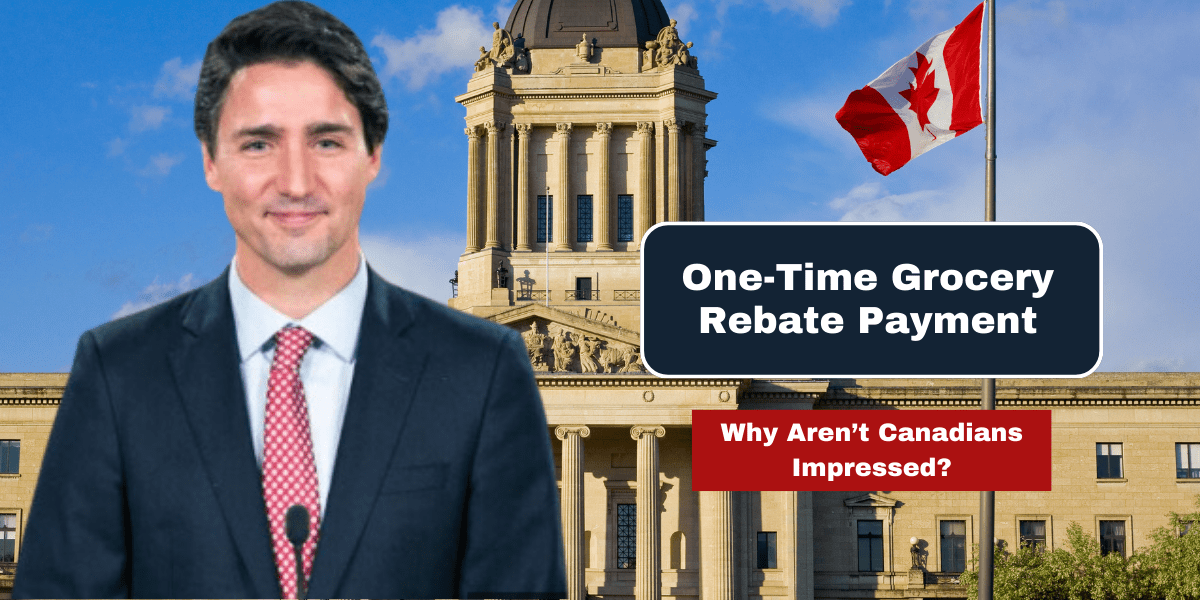One-Time Grocery Rebate Payment: Canada has faced rising food prices and an overall increase in the cost of living, which has particularly affected low- and modest-income households. In response, the federal government launched the Grocery Rebate Program, which provides one-time payments to eligible Canadians to offer some inflation relief. This initiative aims to support around 11 million households with temporary financial aid.
However, the reaction to the rebate has been mixed. While some recipients find the immediate relief beneficial, many feel that the assistance is too brief and inadequate to provide real stability or address long-term food insecurity. For instance, Diane Lane, a senior from Toronto, finds the rebate helpful but believes it is insufficient for making a significant and lasting difference in her financial situation.
Table of Contents
What Is Grocery Rebate In Canada?
In Canada, a grocery rebate is a financial benefit or discount provided to consumers to help offset the cost of grocery purchases. These rebates can come in various forms, such as cash back, discounts at the point of sale, or vouchers for future grocery shopping. They are often offered by government programs, manufacturers, or retailers to alleviate the financial burden of rising food prices or to promote certain products.
Government-administered grocery rebates, for example, are designed to provide relief to low- and middle-income households. These programs aim to make essential food items more affordable and reduce the overall cost of living. Rebates may be delivered through direct payments to individuals or as reductions in grocery store bills, depending on the specific program and its objectives.
| Australia Special Benefits July 2024 |
| Waspi Ombudsman Payment Date 2024 |
| 1900 And 2400 Double Deposits |
| Td1 Form 2024 |
| Canada Public Pension Benefits 2024 |
Canada Grocery Rebate Eligibility
The rebate aims to support around 11 million low- and modest-income households, with eligibility thresholds set at $49,166 for single Canadians without children and higher limits for larger families. Despite this, critics argue that the rebate overlooks many who are also struggling, particularly working couples whose wages are not keeping up with rising costs.
While the eligibility criteria for the grocery rebate in Canada are intended to help low- and modest-income households cope with inflation, the measure’s effectiveness and perceived adequacy differ significantly among those it is meant to assist.
Here’s a table summarizing the details related to the income thresholds, phased-out rebates, and the nature of the payment:
| Aspect | Details |
|---|---|
| Income Thresholds | – Single Canadians without children: Eligible if earning less than $49,166 annually – Families: Income cap increases with the number of children, up to $64,946 for families with four children |
| Phased-Out Rebates | – Rebate amount decreases as income approaches the upper limit of the eligibility range – Aims to target benefits more precisely to those in greater need based on income |
| One-time Payment | – The rebate is a one-time payment – Does not provide ongoing or recurring financial support after disbursement |
Canada Grocery Rebate Concerns : Why Aren’t Canadians Impressed?
Toronto resident Diane Lane’s experience reflects a common sentiment among Canadians. While she appreciates the temporary relief of the approximately $200 rebate, she emphasizes that this amount falls short in offering long-term stability. Lane’s concerns mirror those of many who find that, although the rebate provides brief financial relief, it does little to address the underlying causes of food insecurity and the increasing cost of living.
1. Insufficient Amount for Urban Areas
The grocery rebate provided by the Canadian government often falls short in urban areas where the cost of living and grocery prices are substantially higher. For residents of cities, where food costs can be steep, the rebate may seem minimal and insufficient to cover the increasing grocery bills. Families and individuals who allocate a significant portion of their income to groceries feel the impact of this shortfall the most, as the rebate does not adequately compensate for the steep rise in food prices driven by inflation.
In contrast, in rural areas where food prices are generally lower, the same rebate amount may appear more reasonable. This discrepancy highlights the uneven effectiveness of the rebate across different regions, leading to dissatisfaction among those living in higher-cost areas.
2. Mismatch Between Rebate and Inflation
The grocery rebate amount often fails to keep pace with the rapid increase in food prices. As grocery inflation outstrips the growth of the rebate, its effectiveness as a financial relief tool diminishes. For many consumers, the rebate provides only a minimal buffer against rising costs, which can be frustrating when grocery bills are rising significantly faster than the rebate amount.
This mismatch creates a gap between what people need to manage their grocery expenses and what the rebate offers, resulting in a feeling of inadequate support during times of high inflation. As grocery prices continue to climb, the real value of the rebate diminishes, making it a less effective measure for financial relief.
3. Inequitable Distribution Among Households
The grocery rebate operates on a flat-rate basis, meaning all recipients receive the same amount regardless of their household size or specific needs. This approach does not account for the differing grocery expenses of a single-person household versus a larger family. Consequently, a family of five receives the same rebate as an individual, despite their higher food consumption and expenses.
This inequity means that larger households, which have a higher grocery bill, receive the same relief as smaller households, potentially leaving them with a financial shortfall. The rebate’s uniform distribution fails to address the varying needs of different household sizes, resulting in a less tailored and effective form of assistance.
4. Regional Cost of Living Discrepancies
The cost of living and grocery prices vary significantly across Canada. A rebate amount that might seem adequate in areas with lower living costs can be inadequate in regions with high food prices, such as remote or northern communities. The disparity in regional living costs means that the rebate may not sufficiently alleviate the financial burden in areas where grocery prices are particularly high.
This uneven impact highlights the need for a more region-specific approach to grocery rebates, one that adjusts for local price levels to ensure that the assistance provided matches the cost of living in different areas. Without such adjustments, the rebate can be insufficient for those living in higher-cost regions.
5. Risk of Inflationary Pressures
Providing grocery rebates increases consumers’ purchasing power, which can lead to higher demand for groceries. If the supply of groceries does not meet this increased demand, it can cause a demand-supply imbalance, potentially driving up prices. This situation is particularly concerning in areas with limited competition or supply constraints.
An increase in grocery prices can, in turn, erode the purchasing power of the rebate, leading to demands for further assistance and possibly creating an inflationary spiral. As prices rise, the rebate’s effectiveness diminishes, and the cycle of inflation may continue, undermining the long-term impact of the rebate as a solution to high food prices.
Long-Term Economic Strategies for Addressing Grocery Prices
The debate also includes long-term economic strategies to address grocery prices, such as promoting increased competition in the retail sector or adjusting tax structures to benefit lower-income households. Marc Lee of the Canadian Centre for Policy Alternatives suggests using taxes on windfall profits from industries like oil and gas to fund ongoing support for those most impacted by inflation.
While the grocery rebate payment is a positive step, it highlights the challenges of applying short-term relief measures within a broader economic context. For many Canadians, the rebate is viewed as insufficient, emphasizing the need for more substantial and sustained interventions to ensure economic stability and food security across the country. This ongoing discussion underscores the critical examination of balancing immediate relief with the pursuit of long-term, equitable economic policies.
Conclusion
The Grocery Rebate Program in Canada aims to offer immediate relief to low- and modest-income households facing rising food prices. While it provides some financial assistance, its impact is limited by factors such as inadequate amounts for urban areas, a mismatch with inflation rates, inequitable distribution among households, regional cost disparities, and potential inflationary pressures. The program’s one-time payment nature and flat-rate structure mean that it often falls short of addressing long-term food security and economic stability needs.
To achieve more meaningful and sustainable support, a broader approach involving long-term economic strategies, such as enhancing retail competition and revising tax policies, is necessary. Balancing immediate relief with structural reforms will be crucial for ensuring effective and lasting improvements in food affordability and economic stability.
FAQs
What is the Grocery Rebate Program in Canada?
The Grocery Rebate Program is a federal initiative designed to offer temporary financial aid to low- and modest-income households to help offset the rising cost of groceries. It provides one-time payments to eligible Canadians to alleviate some of the financial pressures caused by inflation.
How does the grocery rebate amount compare to rising food prices?
Many find that the rebate amount does not keep pace with the rapid increase in food prices. As grocery inflation outstrips the growth of the rebate, its effectiveness in providing significant financial relief diminishes, resulting in inadequate support for many households.




